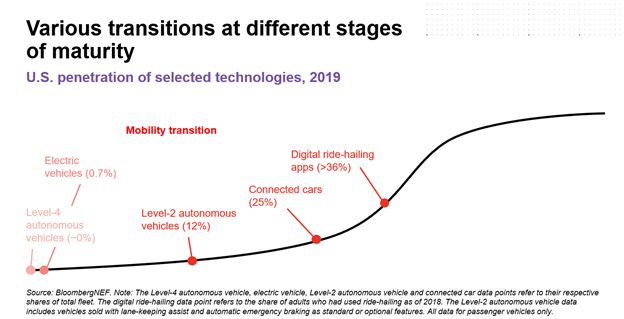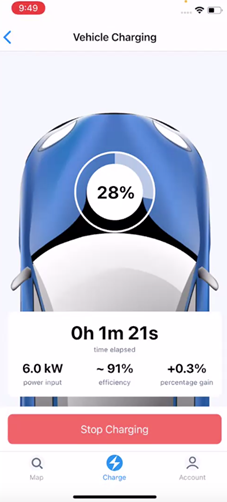

The Electric Transition: A Look at the Future of E-Mobility in the Private and Public Sectors
Medium Friday, January 29th 2021Until recently, electric vehicles have been available to the select few due to high initial prices along with the scarcity of charging stations. However, as the pressure to reduce carbon emissions and slow climate change mounts, governments and corporations are looking to grow and make accessible sustainable options for the public. As part of Dynamo’s Virtual Hub Series, we invited five industry leaders to discuss how the e-mobility industry is shaping and what changes we can look forward to in the coming year. Dynamo Energy Hub Co-Founder Kristin Barbato moderated the conversation, titled “Navigating the Transition to Shared, Electric Mobility”, which brought together policymakers, innovative startups, industry experts, and corporate leaders in the e-mobility space.
Nick Albanese, Head of Intelligent Mobility at BloombergNEF, opened the discussion with some promising statistics on the future of electric vehicles. Despite the overall negative effects the COVID-19 pandemic has had on the automotive industry as a whole, electric vehicles have continued to increase sales year on year. It is expected that by 2040, 60% of vehicles purchased will be electric, with the overall vehicle purchase rate slated to decline as ride-sharing services such as Uber and Lyft continue to expand. Below is a figure of the current growth rate of the EV industry.

Source: BloombergNEF
“In the policy market, EVs have long been driven by subsidies” and the push for decarbonization has led political leaders to do more. However, Nick noted, the growing demand for EVs is making these incentive programs too expensive to maintain, so “we’re moving from a subsidies scheme to more of a regulatory one” with deadlines in terms of when public and private sectors must meet emissions goals.
One company leading the electric transition in the transportation sector is Uber, which “looks at sustainability beyond electrification” through its four pillars: shared; zero emissions; multimodal; inclusive.
By “sharing” rides with other passengers, less emissions will be produced per rider, and Uber’s incentives to go “zero emissions” and utilize electric vehicles further reduce the total emissions produced by their fleet. Ashwin Dias, the Global Head of Vehicles and Electrification at Uber, described Uber’s commitment to sustainability by presenting the company’s goal of reaching zero emissions by 2040.
“Uber has always historically focused on making transportation more reliable, more affordable, more equitable. The next iteration of that is to also make it cleaner”. By pledging to invest $800 million by 2025 in resources to help drivers go electric, Uber’s efforts will improve public interest in purchasing EVs.
Likewise, in the public sector, the NYC Fleet plans to transition fully to electric vehicles by 2040. Their three-part strategy includes direct electrification and indirect emissions reduction. First, the city will electrify whatever it can, including NYPD vehicles and garbage trucks, and will build electric charging stations throughout the city. The vehicles that cannot be electrified yet (like ambulances) will transition into hybrid systems that use a combination of gas and electric. The fleet will work to utilize biofuels and a low carbon fuel standard where fuel is needed. Keith Kerman, the Chief Fleet Officer for the City of New York, stated the department’s goal “to get 50% reduction in greenhouse gas production by 2025 and 80% by 2030”.

Source: DCAS
NYC is an especially important hub to jumpstart changes in the automotive sector. Owning a vehicle in the city involves paying for parking permits and increased gas prices, and with the scarcity of charging stations throughout the city, choosing to switch to electric is an incredible financial burden on residents. With the aid of the public sector promoting these green projects, it is more likely that residents will begin to make their switch to electric. For those who rely on public transportation services, cleaner travel will be made more available as the city commits $16.4 million in incentives to expand electric bus usage, as well as $2.5 million for the purchase of lower emission school buses (as announced in December 2020).
Two innovative EV charging providers, Amply Power and HEVO, also joined the panel to provide insight into their products and present some of the key challenges and possibilities in vehicle electrification. Currently, one major drawback of using electricity as fuel is the volatility of pricing. Within one day, the price of electricity could change over 100%, whereas prices for oil and gas remain relatively constant over a longer period of time. Amply works with power providers to provide more reliable fueling options.
Vic Shao, Founder and CEO, discussed how Amply manages charging stations to make them more efficient and convenient for users. He stated, “we operate chargers just like data centers operate servers…high energy density, high degree of reliability, but at the lowest unit price possible”. Amply offers consistent pricing to allow for the lowest cost charge to consumers and works mainly with public transportation fleets. They evaluate each of their charging systems to ensure reliability in that vehicles will be successfully charged. Their goal is “to give the fleet operator the confidence to move to electric”.

One of those options is HEVO, a wireless EV charging and software company and “the first company in the world to commercialize wireless charging”. Jeremy McCool, Founder and CEO, demonstrated his wireless charging technology, which connects to an app to provide drivers with accurate charging updates. This charger can work wirelessly or with a physical charger and is compatible with any EVs. This is key as not all EV chargers are compatible across brands, and wireless charging eliminates the issue of finding a station specific to your vehicle. To the left is an example of what users can expect from the app, including battery percentage, time remaining to charge, and more.
“As we start to advance into a wireless economy for electric vehicles, there is an ecosystem out there to be able to charge those vehicles,” said McCool.
As the climate targets and deadlines loom closer, there is a nearly palpable international push to find greener, more sustainable solutions for key sectors of our global economy. The car manufacturers slow to modernize will see a decline in revenue as more people and cities chose EVs, and as more and more people, despite the population growth, turn to ride-sharing services and other public transportation methods. To stay relevant and adjust to these changes, the industry must increase its sustainable options for the general public and move away from combustion engine systems. With the new administration, it will be interesting to see what new regulations are put into place to encourage these changes, and how the key stakeholders in the transportation and energy sector respond.
Click here to replay the conversation and hear more from our panelists.
For media relations contact
Claudia Prandoni Marketing & Communications Manager